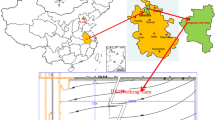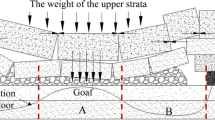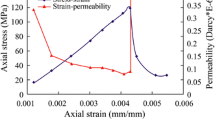Abstract
Water inrush accidents were currently one of the most frequent forms of disaster in coal mines where the mining seams were above a major acquirer with high pressure water. Understanding the fracturing process of mining floor under the effect of highly pressurized water underneath was essential for preventing water inrush. A testing system simulating such cases was developed. This system is comprised of a simulation test bed, a confined water loading system, and a computer monitoring system. A 1900 mm (L) × 220 mm (W) × 1800 mm (H) physical model was constructed, excavated, and monitored using the testing system. The system displayed the development process of floor fractures and the formation of water inrush channels. Based on the stress distribution, the floor rock strata can be divided into five zones, stress stable zone, stress recovery zone, stress reduction zone, stress increase zone, and in situ stress zone. Overall, the floor was in a state of high shear stress under the action of rock stress and high pressure confined water, which was likely to cause shear fracturing and consequently possible water inrush into the mine working faces.











Similar content being viewed by others
References
Cao ZB, Shao HQ, Li JW, Wang XF and Wu BQ (2016) Using coal mine water inrush to calculate hydrogeological parameters. Int J Geomech Geo-China, 9–18
Feng MM, Mao XB, Bai HB, Wang P (2009) Experimental research on fracture evolution law of water-resisting strata in coal seam floor above aquifer. Chin J Rock Mech Eng 28:336–341
Guo H, Yuan L, Shen B, Qu QD, Xue JH (2012) Mining-induced strata stress changes, fractures and gas flow dynamics in multi-seam longwall mining. Int J Rock Mech Min Sci 54:129–139
Hang Y, Zhang GL, Yang GY (2009) Numerical simulation of dewatering thick unconsolidated aquifers for safety of underground coal mining. Min Sci Technol 19:0312–0316
Hu XY, Wang LG, Lu YL, Yu M (2014) Analysis of insidious fault activation and water inrush from the mining floor. Int J Min Sci Technol 24:477–483
Li SC, Li LP, Li SC, Feng XD, Li GY, Liu B, Wang J, Xu ZH (2010) Development and application of similar physical model test system for water inrush of underground engineering. J Mining Saf Eng 27:299–304
Li CP, Li JJ, Li ZX, Hou DY (2013a) Establishment of spatiotemporal dynamic model for water inrush spreading processes in underground mining operations. Saf Sci 55:45–52
Li T, Mei TT, Sun XH, Lv YG, Sheng JQ, Cai M (2013b) A study on a water-inrush incident at Laohutai coal mine. Int J Rock Mech Min Sci 59:151–159
Li SC, Song SG, Li LP, Zhang QQ, Wang K, Zhou Y, Zhang Q, Wang QH (2013c) Development on subsea tunnel model test system for solid-fluid coupling and its application. Chin J Rock Mech Eng 32:883–890
Li SC, Liu RT, Zhang QS, Zhang X (2016) Protection against water or mud inrush in tunnels by grouting: a review. J Rock Mech Geotech Eng 8:753–766
Li XZ, Zhang PX, He ZC, Huang Z, Cheng ML, Guo L (2017) Identification of geological structure which induced heavy water and mud inrush in tunnel excavation: a case study on Lingjiao tunnel. Tunn Undergr Space Technol 69:203–208
Mao DQ, Liu ZB, Wang WK, Li SC, Gao YQ, Xu ZH, Zhang Q (2018) An application of hydraulic tomography to a deep coal mine: combining traditional pumping tests with water inrush incidents. J Hydrol 567:1–11
Miao XX, Pu H, Bai Hb (2008) Principle of water resisting key strata and its application in water preserved mining. J China Univ Min Technol 37:1–4
Shen B, Stephansson O, Rinne M, Amemiya K, Yamashi R, Toguri S, Asano H (2011) FRACOD modeling of rock fracturing and permeability change in excavation damaged zones. Int J Geomech 4:302–313
Shen B, Guo H, Ko TK, Lee SC, Kim J, Kim HM, Park ES, Wuttke MW, Backers T, Rinne M, Stephansson O (2013) Coupling rock fracture propagation with thermal and fluid flow processes. Int J Geomech 13:794–808
Shi LQ, Xu DJ, Qiu M, Jing X, Sun HH (2013) Improved on the formula about the depth of damaged floor in working area. J China Coal Soc 38:209–303
Shi LQ, Qiu M, Wei WX, Xu DJ, Han J (2014) Water inrush evaluation of coal seam floor by integrating the water inrush coefficient and the information of water abundance. Int J Min Sci Technol 24:677–681
Sun WB, Zhang SC (2015) Development of floor water invasion of mining influence simulation testing system and its application. Chin J Rock Mech Eng 34:3274–3280
Sun J, Wang LG, Wang ZS, Hou HQ, Shen YF (2011) Determining areas in an inclined coal seam floor prone to water-inrush by micro-seismic monitoring. Min Sci Technol 21:165–168
Sun J, Wang LG, Hou HQ (2013) Research on water-isolating capacity of the compound water-resisting key strata in coal seam floor. J China Univ Min Technol 42:560–566
Sun J, Hu Y, Zhao GM (2017) Relationship between water inrush from coal seam floors and main roof weighting. Int J Min Sci Technol 27:873–881
Xu, Y.C. and Li, J.B. 2014. Pore-fractured lifting type mechanical model for floor water inrush of the grouting enforcement working face. Journal of China University of Mining & Technology, 43, 49–55
Xu YC, Chen XM, Li JB, Yao YL (2013) Experimental research on floor heave and water inrush in the broken rock roadway under great depth and high water pressure. J China Coal Soc 38:124–128
Yang YT, Li KK (1997) The water inrush mechanism in coal seam floor by the physical analog simulation technique. Coal Geol Explor 25:33–36
Yang WF, Jin L, Zhang XQ (2019) Simulation test on mixed water and sand inrush disaster induced by mining under the thin bedrock. J Loss Prev Process Ind 57:1–6
Zhang JC (2005) Investigations of water inrushes from aquifers under coal seams. Int J Rock Mech Min Sci 42:350–360
Zhang BL, Guo WJ, Zhang XG, Shen B, Zhang T, Kong H (2016) Development and application of analogue testing system for floor confined water rise in coal mining. J China Coal Soc 41:2057–5062
Zhao YX, Jiang YD, Lv YK, Cui ZJ (2013) Similar simulation experiment of bi-directional loading for floor destruction rules in coal mining above aquifer. J China Coal Soc 38:384–390
Funding
The research described in this paper was financially supported by the Taishan Scholar Talent Team Support Plan for Advantaged & Unique Discipline Areas, National Science Foundation of China (No. 51574159), Natural Science Foundation of Shandong Province (No. ZR2018LE008), and Doctoral Research Foundation of Liaocheng University.
Author information
Authors and Affiliations
Corresponding author
Rights and permissions
About this article
Cite this article
Zhang, B., Meng, Z. Experimental study on floor failure of coal mining above confined water. Arab J Geosci 12, 114 (2019). https://doi.org/10.1007/s12517-019-4250-2
Received:
Accepted:
Published:
DOI: https://doi.org/10.1007/s12517-019-4250-2




